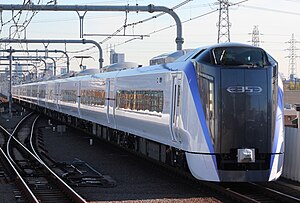E353 series
| E353 series | |
|---|---|

E353 series on a Super Azusa service in December 2017
|
|
| Manufacturer | J-TREC |
| Built at | Yokohama |
| Replaced | E351 series |
| Constructed | 2015– |
| Entered service | 23 December 2017 |
| Number built | 48 vehicles (8 sets) |
| Formation | 9+3 cars per trainset |
| Fleet numbers | S101–, S201– |
| Capacity | 686 (656 standard + 30 Green) |
| Operator(s) | JR East |
| Depot(s) | Matsumoto |
| Specifications | |
| Car body construction | Aluminium alloy |
| Car length | 20,000 mm (65 ft 7 in) (intermediate cars) 21,000 mm (68 ft 11 in) (end cars) |
| Width | 2,920 mm (9 ft 7 in) |
| Height | 3,540 mm (11 ft 7 in) |
| Floor height | 1,130 mm (3 ft 8 in) |
| Doors | One per side |
| Maximum speed | 130 km/h (80 mph) |
| Traction system | Variable frequency (IGBT) |
| Acceleration | 2.0 km/h/s |
| Deceleration | 5.2 km/h/s |
| Electric system(s) | 1,500 V DC |
| Current collection method | PS39 single-arm pantographs |
| Bogies | DT81, DT82 (motored), TR265 (trailer) |
| Safety system(s) | ATS-P, ATS-PS |
| Track gauge | 1,067 mm (3 ft 6 in) |
The E353 series (E353系) is a DC tilting electric multiple unit (EMU) train operated by East Japan Railway Company (JR East) in Japan on limited express services on the Chuo Main Line since December 2017.
A pre-series train, consisting of one nine-car set (set S101) and one three-car set (set S201), was delivered in July 2015 for performance testing. These trains replaced the older E351 series EMUs used on Super Azusa limited express services on the Chuo Main Line between Shinjuku in Tokyo and Matsumoto in Nagano Prefecture. Originally intended to enter revenue service in spring 2016, the first trains entered service on 23 December 2017.
The exterior styling was overseen by the industrial design firm Ken Okuyama Design. Like the E351 series trains which they are scheduled to replace, the new E353 series trains incorporate tilting technology to allow faster speeds around curves. The trains use a pneumatic tilt system (instead of the pendulum system used in the older trains) and an active suspension to reduce tilt times and help reduce motion sickness in passengers. The train features a database of curves along the line, allowing the train to begin tilting before reaching the curve. The pre-series train also had dampers installed between the cars to reduce vibrations, but this feature was discontinued on the subsequent production trainsets. Maximum operating speed will be 130 km/h (80 mph). To reduce any step up from station platforms, the train floor height is 1,130 mm (3 ft 8 in), 10 mm lower than on E259 series and E657 series trains.
Closeup of the gangway connection between sets S101 (left) and S201 (right) in July 2015
The PS39 single-arm pantograph on MoHa E353-1 (car 10) in July 2015
...
Wikipedia
